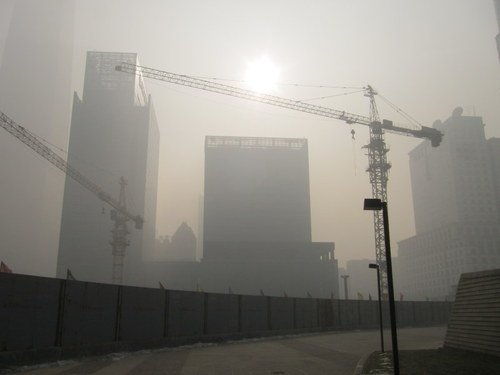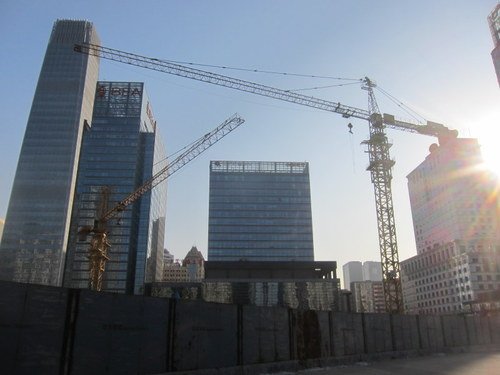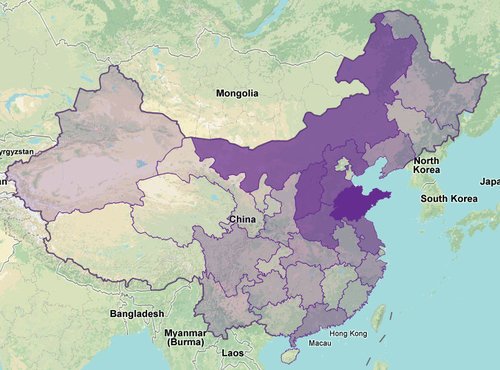Today, for the first time in several days, we're able to see a blue-ish sky outside. As international and Chinese media have widely reported over the last few days, a wide swath of central and eastern China experienced several days of the worst air pollution the country has seen in recent memory, with the haze covering several provinces and some 30 major cities. In Beijing on Saturday night, when the US Embassy's monitoring station reported a peak of 755 for the Air Quality Index (on a scale of 500) and Chinese monitors reported PM 2.5 levels of 993 micrograms per cubic meter (for comparison, China's new 24-hour average standard for residential areas is 75 micrograms per cubic meter, while the WHO's 24-hour average standard is just 25 micrograms per cubic meter), the entire city was wrapped in a dense, stifling fog. (PM 2.5 are the smallest particulate matter with diameters less than 2.5 micrometers, which are the most harmful because they can lodge in the lungs and cause serious health problems.)
Beijing's CBD on Saturday, when the pollution was near its worst…
 … and today (Wednesday), when the severe air pollution of the last few days began to mitigate. The China World Tower, Beijing’s tallest building, is barely visible on the left side of the hazy photo.
… and today (Wednesday), when the severe air pollution of the last few days began to mitigate. The China World Tower, Beijing’s tallest building, is barely visible on the left side of the hazy photo.
 The haze of the last few days has been widely covered by Chinese media, with mainstream media outlets declaring the need to take actions to address pollution in China and urging the public to stay inside and to wear face masks when outside to protect themselves from the pollution. On Tuesday morning, Li Keqiang, China's premier-to-be, addressed the haze, stressing that the air pollution was a long-term problem that required a long-term solution and vowing to take action and increase enforcement of environmental protection. He also voiced support for the government's timely and accurate public reporting of PM 2.5 levels, based on the new air quality standards that took effect January 1st in 74 key air pollution cities. (Hourly air quality data for these cities can be checked via the China National Environmental Monitoring Centre website.)
The haze of the last few days has been widely covered by Chinese media, with mainstream media outlets declaring the need to take actions to address pollution in China and urging the public to stay inside and to wear face masks when outside to protect themselves from the pollution. On Tuesday morning, Li Keqiang, China's premier-to-be, addressed the haze, stressing that the air pollution was a long-term problem that required a long-term solution and vowing to take action and increase enforcement of environmental protection. He also voiced support for the government's timely and accurate public reporting of PM 2.5 levels, based on the new air quality standards that took effect January 1st in 74 key air pollution cities. (Hourly air quality data for these cities can be checked via the China National Environmental Monitoring Centre website.)
In Beijing, the Environmental Protection bureau took emergency measures to address the haze, including halting outdoor activities for primary and middle school students, suspending construction at 28 construction sites, reducing emissions by 30% at 58 factories, and taking up to 30% of government vehicles off the road.
The cause of the haze and how to address it short term and long term.
While the haze the last few days has been of a much more extreme nature and of a longer duration than ever before, the root causes of this particularly severe episode can be traced to existing emissions sources, coupled with a weather "inversion" that trapped the pollution and allowed it to accumulate, rather than allowing it to blow out. (See this helpful China Dialogue article.) The usual suspects are pollution such as sulfur dioxide and nitrogen oxide from coal combustion, which provides 70% of China's energy and 80% of its electricity, and is primarily used by coal power plants, heavy industry such as iron and steel and cement factories, and for residential heating in the winter; emissions from vehicles, particularly heavy vehicles such as trucks; and dust from construction sites. In other words, fossil fuels, particularly coal and oil. (You can see just how reliant northern China is on coal and oil on NRDC's China Climate and Energy Map -- click on the coal and oil buttons on the left.)
 Map of coal consumption in 2010 by province, showing the areas of highest coal consumption in the north of China. Image via the China Climate and Energy Map.
Map of coal consumption in 2010 by province, showing the areas of highest coal consumption in the north of China. Image via the China Climate and Energy Map.
In the short term, cities such as Beijing have begun to develop and implement air pollution emergency response measures, such as shutting or slowing factories and limiting car use, and will be improving forecasting of weather conditions that can lead to severe air pollution and measures to inform the public so that people can take protective measures. The new pollution reporting standards which take wider effect in 74 cities starting this year and include hourly PM 2.5 reporting are an important step in improving the availability of pollution information so that the government, enterprises and the public can take action to improve air quality and protect themselves from pollution.
In the longer term, however, China's persistent regional air pollution problems require a more systematic and sustained approach that includes:
• Strengthening monitoring and enforcement of pollution removal equipment such as SO2 scrubbers and NOx removal equipment for coal power plants and factories. (Emissions standards for coal power plants were strengthened last year, as my colleague Barbara Finamore blogged on);
• Expanding the use of low-sulfur fuels and emissions systems for vehicles, particularly for heavy vehicles such as trucks and buses. Vance Wagner from ICCT has written on the need to move without delay to less-polluting China IV fuels and emission systems and to put in place a timeline for global best practice China VI standards;
• Shifting China's industrial structure away from heavy industry and towards less-polluting industry and services, a goal that has so far eluded policymakers. And of course, greater energy efficiency in industry, building, appliances and vehicles, so that we use less electricity and burn less coal and oil in the first place, is also key.
• Improving regional efforts to address air pollution, particularly in key air pollution regions. The Ministry of Environmental Protection released its "Twelfth Five Year Plan for Air Pollution Prevention and Control in Key Areas" (see Chinese here) in December, which sets targets for reduction of key pollutants by 2015 such as reducing PM 2.5 in the Beijing-Tianjin-Hebei region and the Yangtze and Pearl River Deltas by 5%. It also emphasizes joint regional coordination and management of air pollution by city and provincial governments.
Fundamentally, China needs to shift its energy supply structure away from its heavy reliance on polluting coal by increasing the use of cleaner-burning natural gas and non-polluting renewable energy sources such as wind and solar. On the renewables front, China has a goal of increasing its use of non-fossil energy to 15% of primary energy consumption by 2020, has greatly increased wind power over the last several years, and in the last few months has announced new policies and targets to greatly expand the use of solar PV, particularly distributed roof-top PV.
Establishing a coal consumption cap policy that would limit the use of and growth of coal in key air pollution areas would add an important policy lever to existing policies such as China's energy and carbon intensity targets and plans to implement a total energy consumption target. China consumed 3.6 billion tons of coal in 2011, half the world's coal consumption, and there are proposals to build some 558 GW of new coal-fired power plants according to a recent WRI global coal risk assessment (a 73% increase over China's 2011 thermal power plant capacity). Such continued growth in coal consumption is simply unsustainable, no matter how many scrubbers are operating on power plants.
Limiting the growth of coal is a key part of addressing China's energy and pollution challenges. The Ministry of Environmental Protection is already engaged in planning coal consumption cap pilots in the key regions of Beijing-Tianjin-Hebei, the Pearl River Delta, Yangtze River Delta and Shandong city cluster as part of its "Twelfth Five Year Plan for Air Pollution Prevention and Control in Key Areas." Establishing a coal cap in these areas will increase the use of more efficient and cleaner technologies such as renewables and combined heat and power, and provide an example for how coal use can be controlled in other regions.
Addressing the root causes of China's severe air pollution will not be done overnight, but a long-term problem requires a long-term solution, one that can effectively and permanently clear the haze today and for generations to come.


